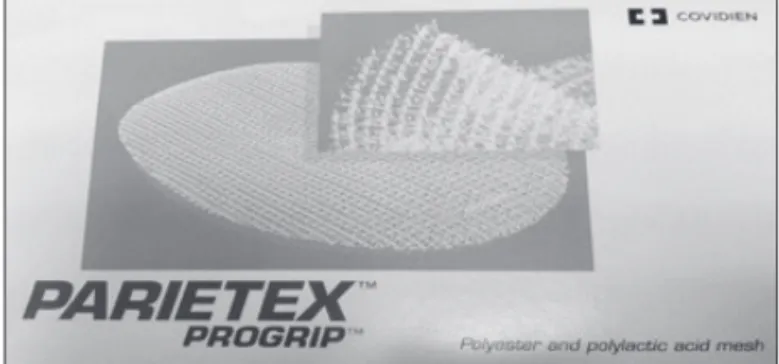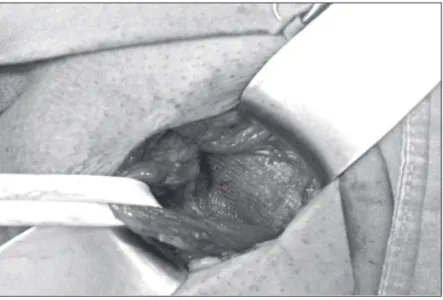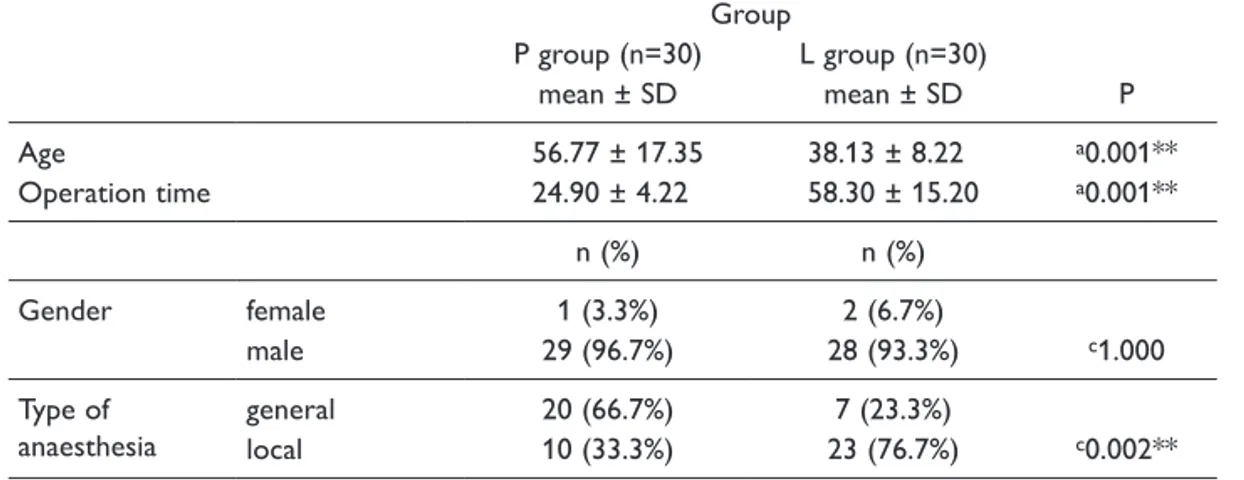Self-gripping Covidien™ ProGrip™ Mesh
versus Polypropylene Mesh in Open Inguinal
Hernia Repair: Multicenter Short
Term Results
Yilmaz A.1, Yener O.2, Kaynak B.1, Yiğitbaşı R.2, Demir M.2, Burcu B.2,
Aksoy F.2
1Faculty of Medicine, Istanbul Medipol University, Istanbul, Turkey;
2Faculty of Medicine, Istanbul Medeniyet University, Göztepe Training and Research Hospital, Istanbul, Turkey
Received August 6, 2013; Accepted November 25, 2013.
Key words: Mesh – Inguinal hernia
Abstract: The purpose of this study was to compare clinical outcomes
following sutureless ProGrip™ mesh repair to traditional Lichtenstein repair with polypropylene mesh secured with sutures. Data were collected prospectively and were analyzed for 57 male and 3 female patients with 60 inguinal hernias. All patients included underwent open surgical repair for inguinal hernia with polypropylene mesh or ProGrip mesh. In our two centres study sixty patients were operated; 30 were treated with Lichtenstein repair with polypropylene mesh (L group) and 30 with ProGrip mesh (P group) with or without fixation. The primary parameter measured was intensity of postoperative pain using visual analogue scale (VAS); other outcomes included assessment of early and late complication. VAS was assessed in 7 days and 4 months of the postoperative period. Our results show that VAS scored at the 7th postoperative day was 1.5 for the ProGrip mesh versus 4.4 in Lichtenstein repair group. The difference between groups was statistically significant (P=0.001). Surgery duration was significantly shorter in the P group (24.9 vs. 58.3 min; P=0.001). No recurrence was observed at 3 months in both groups. The 3-months follow-up has shown that time necessary to return to daily routine activity was significantly lower in the P group during the (P=0.001). Surgery duration, early and late postoperative, pain and return to daily routine activity rates were significantly reduced with self-gripping ProGrip mesh compared to Lichtenstein repair with polypropylene mesh. –––––––––––––––––––
Mailing Address: Dr. Oktay Yener, Faculty of Medicine, Istanbul Medeniyet
University, Göztepe Training and Research Hospital, Plaj Yolu Kaya apt. No. 16 D:10 Caddebostan, Istanbul, Turkey; Mobile Phone: +905 337 088 469;
Introduction
Inguinal hernia regardless of type is one of the most common diseases that a surgeon has to manage. Improved surgical techniques and a better understanding of the anatomy and physiology of the inguinal canal have significantly improved outcomes for many patients. Inguinal hernia repair has been evolving for the past 130 years and the pace of evolution accelerated in the last decade with the introduction of the tension-free repair, the laparoscopic repair and with organizing the specialized hernia clinics.
Traditional suture repair of inguinal hernia is fast giving way to routine tension-free mesh repair. This operation is called a “hernioplasty”. In many countries, mesh repair is now more common than suture repair. Lichtenstein presented his open mesh repair technique for inguinal hernia in 1986. The Lichtenstein technique has since become the most frequently used one (Lichtenstein and Shulman, 1986; Lichtenstein et al., 1989).
The repair of an inguinal hernia is one of the most common operations performed in general surgery with significant costs to health care and society. Rates of repair increase annually and have a potential to double in the near future. Since its introduction, the Lichtenstein mesh repair has been the most widely performed in groin hernia repair and is used as the gold standard to which other techniques are compared.
The Lichtenstein technique performed and refined over several decades, revolutionized hernia surgery as a result of its reduced risk for morbidity and its potential use in patients previously unsuitable for this type of procedure (Lichtenstein, 1970). Surgeons quickly popularized this technique of tension-free mesh hernia repair, and it became the gold standard for the treatment of inguinal hernias, of which approximately 600,000 are surgically treated each year in the United States (Lichtenstein and Shore, 1974). Since the introduction of Lichtenstein mesh repair, overall hernia recurrence rates have fallen to 2% or less.
Self-gripping mesh
In 2008, Covidien launched ProGrip™ mesh (Figure 1), a self-gripping mesh
indicated for the use in inguinal and incisional hernia repairs. ProGrip™ as designed
Figure 1 – Parietex ProGrip mesh manufactured by Covidien.
to offer patients greater comfort following surgery, and allow physicians the ability to position and secure the mesh in less than 60 seconds, which may contribute to the reduction of operation time (Kapischke et al., 2010).
The macroporous polyester mesh has resorbable polylactic acid (PLA) micro-grips on one side of the mesh, which secure quickly without sutures, tacks, fibrin glue, or any other form of fixation (Chastan, 2006).
The aim of this study was to compare clinical outcomes following sutureless ProGrip™ mesh repair to traditional Lichtenstein repair with lightweight polypropylene mesh secured with sutures.
Material and Methods
The study was performed in two different University Hospitals. Data were collected prospectively and were analyzed for 57 male and 3 female patients with 60 inguinal hernias between October 2012 and June 2013. All patients included underwent open surgical repair for inguinal hernia by prolen mesh and ProGrip mesh. This is a 3-months two centres study. Sixty patients were operated; 30 were treated with Lichtenstein repair (L group) and 30 with ProGrip mesh (P group) with or without fixation.
Patients were consecutively included in the protocol. Exclusion criteria were laparoscopic hernia repair and recurrent inguinal hernias.
Description of the ProGrip mesh
The procedures were performed using the parietex ProGrip mesh manufactured by Covidien. The macroporous polyester mesh has resorbable polylactic acid (PLA) micro-grips on one side of the mesh, which secure quickly without sutures, tacks, fibrin glue, or any other form of fixation (Figure 1).
Patient data
Sixty patients were included in the study. Data collection used standardized clinical report forms. Preoperative information of the patient was obtained: hernia type, previous treatment, preoperative pain measured via visual analogue scale (VAS) graduated from 0 to 10. Peroperative data was collected: type of hernia, operative time, peroperative complications.
Early and late postoperative complications were recorded. Postoperative pain was assessed by VAS. Clinical follow up was performed at seven day and one month; complications, pain (VAS) and recurrence were
carefully collected.
Surgical technique
The Lichtenstein operation was performed as described by Amid et al. (1993) using 2-0 polypropylene (Prolene) to secure the mesh. We used a 10×15 cm polypropylene mesh (that was trimmed to match the size of the inguinal floor if
necessary). After closure of the external oblique and Scarpa’s fascia, the skin was closed with a running 3-0 prolene (Figure 2).
The surgical technique recommended for parietex ProGrip Covidien mesh as follows: after a 6 to 9 cm skin incision, the external oblique aponeurosis is incised. The spermatic cord is carefully dissected. The inguinal ligament is dissected towards the pubis up to the anterior superior iliac spine. A wide dissection of the conjoint tendon and the rectus muscle aponeurosis is performed up to the linea alba as to create the space required to spread out the mesh. The mesh is then opened from its packing and any folding of the mesh should be avoided. The self gripping flap of the mesh is then opened and closed around the cord outside the operating area in order to avoid any untimely side by side placement. The mesh is then spread down carefully to its final position, its fixation starting inferiorly to the high right muscle and to the adjacent inguinal ligament. No additional fixation suture is required.
Data handling
Data were collected according to standardized preprinted pro-forms at each hospital. They were collected and statistical analyses were performed.
Statistical analysis
All data were analyzed using NCSS (Number Cruncher Statistical System) 2007&PASS, 2008 statistical software. Student’s t-test and Mann-Whitney U test was used. The Fischer’s exact test and Yates’ continuity correction test were used to assess the differences between categorical data. P<0.05 was considered statistically significant.
Results
Sixty patients were followed-up for three months. Mean operative time was significantly shorter in the ProGrip mesh group at 24.9 ± 4.2 compared to 58.3 ± 15.2 in the Lichtenstein group (P<0.01). There were no perioperative complications and no conversions to another method in any group (Table 1).
The VAS score was lower in the P group patients than the L group patients after 7 days (P=0.001) and 4 weeks (P=0.036). There were no statistical differences between two group preoperative VAS score (P=0.052) (Table 2).
There were no major complications. The postoperative complications (<30 days) recorded are shown in Table 3. There were no significant differences between the groups. None of the hematomas needed evacuation. All infections healed without surgical intervention. Return to daily routine activity was statistically significant between two groups (Table 4).
Table 1 – Age, gender, operation time and anaesthesia type distribution between two groups
Group P P group (n=30) L group (n=30) mean ± SD mean ± SD Age 56.77 ± 17.35 38.13 ± 8.22 a0.001** Operation time 24.90 ± 4.22 58.30 ± 15.20 a0.001** n (%) n (%) Gender female 1 (3.3%) 2 (6.7%) c1.000 male 29 (96.7%) 28 (93.3%) Type of
anaesthesia generallocal 20 (66.7%)10 (33.3%) 23 (76.7%)7 (23.3%) c0.002** aStudent’s t-test; cYates’ continuity correction test; **P<0.01
Table 2 – Evaluation of VAS scores between two groups
Group
P P group (n=30) L group (n=30)
min–max mean ± SD median min–max mean ± SD median Preoperative
VAS 0–4 2.07 ± 1.20 2.00 0–3 1.43 ± 1.04 1.50 b0.052
VAS 7 days 0–3 1.53 ± 0.97 1.00 0–8 4.40 ± 2.48 5.00 b0.001**
VAS 4 weeks 0–4 0.60 ± 1.10 0.00 0–6 1.33 ± 1.58 1.00 b0.036* VAS – visual analogue scale; bMann-Whitney U test; *P<0.05; **P<0.01
Table 3 – Evaluation of postoperative early complication between two groups
Group P P group (n=30) L group (n=30) n (%) n (%) Recurrences 0 (0.0%) 0 (0.0%) – Vessel injury 1 (3.3%) 0 (0.0%) d1.000 Haematoma 3 (10.0%) 1 (3.3%) 0.612 Infection 1 (3.3%) 0 (0.0%) d1.000 Complication of anaesthesia 0 (0.0%) 0 (0.0%) –
dFisher’s exact test
Table 4 – Evaluation of return to daily routine activity and hospital stay between two groups
Group
P P group (n=30) L group (n=30)
min–max median min–max median
Return to daily routine activity 2–8 4.00 5–28 20.00 b0.001**
n (%) n (%)
Hospital stay first day 28 (93.3%) 30 (100.0%) d0.492
second day 2 (6.7%) 0 (0.0%)
bMann-Whitney U test; dFisher’s exact test; **P<0.01
Discussion
The ideal outcome in inguinal hernia surgery is to provide a recurrence-free repair while minimising the morbidity, disability and both acute and chronic pain that the patient may experience. Presently, this outcome has yet to be definitively achieved after more than 100 years of hernia surgery. The introduction of meshes helped surgeons to achieve a recurrence rate of less than 5%. On the contrary, chronic pain, of neuralgic origin, has emerged as one of the most important negative clinical sequel which can follow inguinal hernia repair. The pathogenesis of chronic pain, defined as sustained discomfort/pain after 3 months is not clearly understood (Shin et al., 2005).
Usher first introduced polypropylene prosthetics for inguinal hernia in the late 1950s (Usher, 1959), however, the wide acceptance of them took place in 80’s following Lichtenstein’s report of very successful results (Klosterhalfen et al., 2005). Meshes have decreased the rate of recurrence significantly, but some problems related to meshes have been reported. As a foreign body, mesh theoretically may
increase the risk of infection. However, as mentioned above, surgical site infection is not a big problem in inguinal hernia repairs. Rejection and mesh removal due to chronic resistant infection is very rare. A hernia mesh has certain features like material, strength, elasticity, density, pore size. Standard polypropylene mesh is most frequently used one. It is cheap, available in most institutions, non-absorbable, and strong enough to avoid recurrence. Nevertheless, some actual problems with mesh use like foreign body sensation and chronic postoperative pain have created a conflict about standard polypropylene mesh. Polyester mesh might be an alternative, but it could not gain popularity. Polyester meshes can degrade by time especially in infected areas (Earle and Mark, 2008).
Newer lighter meshes have been produced to overcome those problems (Shah et al., 2009). Nevertheless, all lightweight meshes are more expensive than standard polypropylene mesh. Pure polypropylene light mesh is the most economic option. There are also coated polypropylene meshes in the market. The purpose of the coating is to attenuate the host response to the prosthetic, yet still provide adequate strength for repair (Klinge et al., 1999).
In conclusion, surgery duration, early and late postoperative, pain and return to daily routine activity rates were significantly reduced with self-gripping ProGrip mesh compared to Lichtenstein repair with polypropylene mesh. ProGrip self adhesive mesh repairs are superior to prolene mesh repairs in surgery of inguinal hernias.
References
Amid, P. K., Shulman, A. G., Lichtenstein, I. L. (1993) Critical scrutiny of the open “tension-free” hernioplasty. Am. J. Surg. 165, 369–371.
Chastan, P. (2006) Tension-free open inguinal hernia repair using an innovative self-gripping semi-resorbable mesh. J. Minim. Access Surg. 2, 139–143.
Earle, D. B., Mark, L. A. (2008) Prosthetic material in inguinal hernia repair: how do I choose? Surg. Clin.
North Am. 88, 179–201.
Kapischke, M., Schulze, H., Caliebe, A. (2010) Self-fixating mesh for the Lichtenstein procedure: a prestudy.
Langenbecks Arch. Surg. 395, 317–322.
Klinge, U., Klosterhalfen, B., Müller, M., Anurov, M., Ottinger, A., Schumpelick, V. (1999) Influence of polyglactin-coating on functional and morphologic parameters of polypropylene-mesh modifications for abdominal wall repair. Biomaterials 20, 613–623.
Klosterhalfen, B., Junge, K., Klinge, U. (2005) The lightweight and large porous mesh concept for hernia repair.
Expert Rev. Med. Devices 2, 103–117.
Lichtenstein, I. L. (1970) Hernia Repair without Disability. C.V. Mosby, St. Louis.
Lichtenstein, I. L., Shore, J. M. (1974) Simplified repair of femoral and recurrent inguinal hernias by a “plug” technique. Am. J. Surg. 128, 439–444.
Lichtenstein, I. L., Shulman, A. G. (1986) Ambulatory outpatient hernia surgery. Including a new concept, introducing tension-free repair. Int. Surg. 7, 1–4.
Lichtenstein, I. L., Shulman, A. G., Amid, P. K., Montllor, M. M. (1989) The tension-free hernioplasty. Am. J. Surg.
Shah, B. C., Goede, M. R., Bayer, R., Buettner, S. L., Putney, S. J., McBride, C. L., Oleynikov, D. (2009) Does type of mesh used have an impact on outcomes in laparoscopic inguinal hernia? Am. J. Surg. 198, 759–764.
Shin, D., Lipshultz, L. I., Goldstein, M., Barmé, G. A., Fuchs, E. F., Nagler, H. M., McCallum, S. W., Niederberger, C. S., Schoor, R. A., Brugh, V. M. 3rd, Honig, S. C. (2005) Herniorrhaphy with polypropylene mesh causing inguinal vasal obstruction: a preventable cause of obstructive azoospermia. Ann. Surg. 241, 553–558.
Usher, F. C. (1959) Further observations on the use of Marlex mesh: a new technique for the repair of inguinal hernias. Am. Surg. 25, 792–795.



